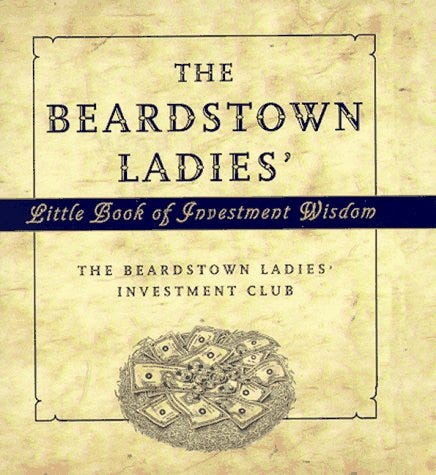There’s a great quote from the Wolf of Wall Street where Jordan Belfort, Leonardo DiCaprio’s character says:
“The only thing standing between you and your goal is the story you keep telling yourself as to why you can’t achieve it."
It takes a shift in mindset, but each of us can make good things happen, and when we join forces as a community, the impact is magnified.
Take financial investment for example. For many it can seem like its not even their own dream, that it is something only others in better circumstances can dream about. Now, to change the story we keep telling ourselves, it’s simply not true.
Financial independence is an aspiration most of us share. It won’t happen without action, and community-based investment clubs are emerging as a practical answer for collective wealth-building, and small steps towards financial freedom.
These are grassroots organizations that bring people together to pool resources, share knowledge, and invest as a group. It is as far as you can get from the high-stakes world of Wall Street, and yet Jordan Belfort is right, and we need to get over any feelings of helplessness and change the game.
Community-based investment clubs democratize investing, make it accessible, educational, and social. Their popularity continues to grow, fueled by a desire for financial empowerment and a sense of community in an increasingly digital age. They are worth exploring.
What Are Community-Based Investment Clubs?
At their core, investment clubs are small groups of individuals who meet regularly to contribute money to a collective fund, which is then invested in stocks, bonds, real estate, or other assets. Decisions are typically made democratically, with members researching opportunities, debating strategies, and voting on where to allocate their capital. While some clubs focus on traditional markets, others explore emerging trends like cryptocurrency, sustainable startups, or local business ventures. Their focus will depend upon the interest and analysis of the people involved.
Historically, investment clubs date back to the 19th century, but they gained traction in America during the mid-20th century with organizations like the National Association of Investors Corporation (NAIC), now BetterInvesting (BetterInvesting, n.d.).
Today’s clubs are evolving globally, leveraging technology and community networks to adapt to modern financial landscapes. They have come of age and come into their own.
Why Join an Investment Club?
The appeal of community-based investment clubs lies in their blend of education, affordability, and camaraderie. For many, the stock market or real estate can feel intimidating, rife with jargon, risk, and uncertainty. Clubs break down these barriers and provide a collaborative environment where novices and seasoned investors learn together.
Affordability: Pooling funds allows members to invest in opportunities beyond individual reach. A £50 from 10 members creates a £500 pool. This is enough to diversify across assets.
Education: Clubs double as learning hubs. Members research companies, analyze trends, and share insights, building financial literacy collectively (Harrington, 2008).
Community: Meetings—whether in-person or virtual—offer a space to discuss goals, celebrate wins, and navigate losses together, countering the isolation of solo online trading.
Risk Management: Group decision-making tempers impulsive choices, with diverse perspectives often leading to balanced strategies.
How They Work in Practice
If you are interested in joining one or forming one, most investment clubs operate simply: members agree on a monthly contribution, say, £20 to £100, and establish decision-making rules. Some formalize as partnerships or LLCs for tax and liability purposes, while others remain informal. Meetings might involve presentations on investment options, followed by votes or consensus. You make the rules together.
Technology has enhanced this model. Platforms like Robinhood, eToro, or Discord enable real-time portfolio management and strategy discussions. Some clubs use AI tools to analyze data, leveling the playing field with institutional investors (Smith, 2023). A benefit of coming together is that different people bring different knowledge and skillsets, including the tech savvy.
Success Stories
Investment clubs have produced inspiring successes worldwide. I thought I’d share a few examples to illustrate this.
The Beardstown Ladies (USA): Formed in 1983 in Beardstown, Illinois, this all-women club of 16 gained fame in the 1990s. Starting with modest contributions, they focused on value investing, claiming 23.4% annualized returns in their book (Beardstown Ladies & Feuer, 1994). Audits later adjusted this to 9.1% (Harrington, 2008), but their story inspired countless clubs, showing ordinary people could tackle markets. I’m going to return to this example at the end as it’s quite a story.
Property Club (Australia): Founded in 1994, this Australian club has grown into a network helping thousands invest in property. Members like Nicolas and Frances Smyth won a $50,000 giveaway in 2018, boosting their portfolio after prior successes. Another member, Venu Thamotharan, transitioned from IT to property investing post-2013, leveraging club mentorship to build wealth in Brisbane’s market (Property Club, 2018). The club’s focus on education and community has made it a model for property investment.
Pam Stebbings’ All-Female Investment Club (UK): Started in 2000 by Pam Stebbings and 12 friends, this UK club grew a portfolio to nearly £140,000 by 2021. Beginning with £30 monthly contributions (later £40), they invested in stocks like Ocado and Genus, achieving strong returns—Genus alone yielded 27.47% annualized returns over five years (Morningstar, 2021). Their democratic approach and social meetings highlight the power of collective effort.
The Capital Gains Investment Club (USA): Based in California, this club, active since the 1970s, reached a portfolio value of $1,008,998.23 by 2019. It paid out over $831,284.94 to withdrawing members, crediting success to disciplined equity investing and education (BetterInvesting, n.d.).
Challenges to Overcome
Success isn’t guaranteed. Disagreements over investment choices can strain relationships, and losses test group cohesion. Legal and tax complexities require navigation of securities regulations (Harrington, 2008). In an era of meme stocks and crypto hype, maintaining discipline is challenging.
Not every club succeeds, and you should be ready for that.
The Future of Investment Clubs
As of 2025, investment clubs are poised for a global renaissance. Economic uncertainty and distrust in traditional finance fuel interest in decentralized alternatives. Younger generations, especially Gen Z and Millennials, embrace clubs to blend social impact with financial gain, often prioritizing ethical investments (Jones, 2024).
Web3 and blockchain could transform the space, for example by tokenized membership shares or smart contracts for automation. Online communities on platforms like X amplify the movement, with users forming virtual clubs and sharing ideas.
Getting Started
Starting a club is straightforward: gather trusted individuals, define goals (growth, income, learning), and set a contribution level. Research options like index funds and establish a decision-making process. Resources like BetterInvesting or local workshops offer guidance (BetterInvesting, n.d.).
Ultimately, investment clubs are about empowerment and collaboration. From the Beardstown Ladies to Property Club’s Australian investors, these groups prove collective effort can yield remarkable results. In a fluctuating economic world, they show wealth-building can be a shared adventure, one meeting at a time.
I thought we’d go a little deeper into this with a case study.
Case Study: The Beardstown Ladies Investment Club: Small Investments, Collective Power, and Financial Freedom
Formation in 1983
In 1983, in the small, agricultural town of Beardstown, Illinois, 16 women formed an investment club that would become a symbol of grassroots financial empowerment. Ranging in age from their 40s to 70s, the group included homemakers, teachers, a farmer, a bank teller, and a retired chemist, most with no prior investing experience (Beardstown Ladies & Feuer, 1994).
The club was sparked by Betty Sinnock, a former bank employee inspired by a financial seminar to explore the stock market. Tired of being sidelined in a male-dominated field, she rallied friends and neighbors to pool their resources and learn together.
They named themselves the Beardstown Business and Professional Women’s Investment Club, later known as the “Beardstown Ladies.” Each member committed to a modest $25 per month which was a sum equivalent to about £20 in 1983, akin to the £50 you asked about relative to £500 (roughly 10% of a small budget).
They met monthly in a church basement, sharing coffee, homemade pies, and a determination to master investing. This collective spirit echoed Cesar Chavez’s words: “We cannot seek achievement for ourselves and forget about progress and prosperity for our community” (as cited in Pawel, 2014). Their small contributions weren’t just financial, they invested time, trust, and curiosity, laying the foundation for financial independence.
Investment Approach: Value Investing with Heart
The Beardstown Ladies embraced value investing, seeking undervalued companies with strong fundamentals, much like Warren Buffett’s philosophy: “You don’t need to do extraordinary things to get extraordinary results” (as cited in Lowe, 1997). They chose businesses they understood, household names like Coca-Cola, McDonald’s, or Sears, often researching by reading annual reports, clipping newspaper articles, or visiting stores to gauge customer traffic.
Their method was hands-on: the chemist analyzed drug companies, the farmer vetted agribusinesses, and others brought insights from daily life, like noticing busy parking lots at Walmart.
Monthly meetings doubled as learning sessions. Members presented stock picks, debated price-to-earnings ratios, and voted democratically on investments. Their $25 contributions pooled into a portfolio that grew steadily, proving John Bogle’s maxim: “The greatest enemy of a good plan is the dream of a perfect plan. Stick to the good plan” (Bogle, 2007).
By focusing on consistent, modest investments, similar to your £50 example, they built wealth without chasing fads, embodying the discipline of The Richest Man in Babylon: “Start thy purse to fattening: take from thy earnings a part to keep” (Clason, 1926/2002).
Fame in the 1990s
By the early 1990s, the Beardstown Ladies had transformed their modest stakes into a portfolio reportedly worth over $180,000. Their story caught fire with the 1994 publication of The Beardstown Ladies’ Common-Sense Investment Guide (Beardstown Ladies & Feuer, 1994), which claimed an annualized return of 23.4% from 1983 to 1993. This outpaced the S&P 500’s 14.5% over the same period (Harrington, 2008).
The book became a bestseller, blending folksy advice with practical tips, like “buy what you know.” Media outlets, from The Oprah Winfrey Show to The Wall Street Journal, celebrated their success, dubbing them the “grandmas who beat Wall Street.”
Their fame mirrored Moneyball’s ethos: “We’re looking for players that other teams don’t see value in, because that’s where the value is” (Lewis, 2003; as adapted in Miller, 2011). Like Billy Beane’s undervalued baseball players, the Ladies found overlooked stocks, and their collective $25 bets, scaled to thousands over years, suggested anyone could achieve financial freedom. Their story inspired countless women and small investors, with investment clubs surging to over 35,000 nationwide by 2000 (Harrington, 2008).
Controversy Over Returns
It is still a good news story, even though the reality didn’t quite live up to the hype.
In 1998, skepticism about their 23.4% claim prompted an audit by PricewaterhouseCoopers. The review found they had mistakenly included member contributions as investment gains, inflating their performance.
The corrected annualized return for 1983–1993 was 9.1%, still solid but below the S&P 500’s 14.5% (Harrington, 2008). The error sparked criticism, with some accusing them of hype, though the Ladies maintained it was an honest mistake.
The truth, as The Big Short’s Mark Baum said, is “like poetry. And most people hate poetry” (McKay, 2015). The 9.1% return was less dazzling but meaningful, $25 monthly at 9.1% over 10 years grew to around $4,000 per member.
It was enough for retirement boosts, travel, or family support. In The Pursuit of Happyness there’s a great message that goes: “You got a dream, you gotta protect it” (Muccino, 2006). Their small investments, even at corrected returns, freed them from financial constraints.
Lasting Impact
The Beardstown Ladies’ legacy transcends the controversy. Their books, five in total, including The Beardstown Ladies’ Stitch-in-Time Guide to Growing Your Nest Egg (Beardstown Ladies & Dellabough, 1996), and media appearances empowered ordinary people, especially women, to engage with markets. They showed that small sums, like £50 out of £500, could compound into security when pooled collectively. By 2000, their influence helped fuel a boom in investment clubs, teaching diversification and discipline (Harrington, 2008).
There’s a line in It’s a Wonderful Life that goes: “You’ve really had a wonderful life. Don’t you see what a mistake it would be to throw it away?” (Capra, 1946). Like George Bailey’s small acts, their $25 contributions built a richer life, not just financially but socially, through shared learning and empowerment.
For members, gains funded personal goals, from education to charity, embodying freedom from want.
Connecting to £50 of £500
In a modern club, £50 might buy fractional shares via platforms like eToro, with similar discipline yielding 6–8% annually (e.g., £50 at 7% becomes £98.36 in 10 years).
Benefits include:
Growth: Compounding turns small sums into meaningful savings, reducing reliance on wages.
Education: Clubs teach market savvy, as Rich Dad Poor Dad’s “The rich have money work for them” suggests (Kiyosaki & Lechter, 1997).
Community: Pooling £50 creates diversified portfolios, lowering risk and boosting confidence, like their $25 stakes.
Freedom: Gains fund goals, debt payoff, travel, retirement—echoing The Shawshank Redemption: “Get busy living, or get busy dying” (Darabont, 1994).
Modern Context
Today, investment clubs thrive online, with apps lowering barriers. A £50 contribution could join a UK club investing in FTSE 100 ETFs or global tech. While markets differ, 1983 lacked crypto volatility or AI booms, the Ladies’ focus on value and collaboration endures, proving small investments can liberate.
Small dreams can make a nice difference in our lives and the lives of those around us.
References
Beardstown Ladies, & Dellabough, R. (1996). The Beardstown Ladies’ stitch-in-time guide to growing your nest egg. Hyperion.
Beardstown Ladies, & Feuer, L. (1994). The Beardstown Ladies’ common-sense investment guide: How we beat the stock market—and how you can, too. Hyperion.
BetterInvesting. (n.d.). Member stories. https://www.betterinvesting.org/member-stories
Bogle, J. C. (2007). The little book of common-sense investing: The only way to guarantee your fair share of stock market returns. John Wiley & Sons.
Capra, F. (Director). (1946). It’s a wonderful life [Film]. Liberty Films.
Clason, G. S. (2002). The richest man in Babylon. (Original work published 1926). Penguin Books.
Darabont, F. (Director). (1994). The Shawshank redemption [Film]. Castle Rock Entertainment.
Harrington, B. (2008). Pop finance: Investment clubs and the new investor populism. Princeton University Press.
Jones, K. (2024). The new wave of community investing: Social impact and financial returns. Journal of Financial Innovation, 12(3), 45-60.
Kiyosaki, R. T., & Lechter, S. L. (1997). Rich dad poor dad: What the rich teach their kids about money—that the poor and middle class do not!. Warner Books.
Lowe, J. (1997). Warren Buffett speaks: Wit and wisdom from the world’s greatest investor. John Wiley & Sons.
McKay, A. (Director). (2015). The big short [Film]. Paramount Pictures.
Miller, B. (Director). (2011). Moneyball [Film]. Columbia Pictures.
Morningstar. (2021, June 23). Investor views: All female investor club toasts share success. https://www.morningstar.co.uk/uk/news/212345/investor-views-all-female-investor-club-toasts-share-success.aspx
Muccino, G. (Director). (2006). The pursuit of happyness [Film]. Columbia Pictures.
Pawel, M. (2014). The crusades of Cesar Chavez: A biography. Bloomsbury Press.
Property Club. (2018, October 29). Success stories. https://www.propertyclub.com.au/success-stories
Smith, T. (2023). Tech-driven investing: How AI and platforms are reshaping retail finance. Tech Finance Review, 8(2), 22-35.
Footnotes
If you’ve enjoyed this article, please join our community and help share the message through subscribing, clicking like, and restacking to your community.
My latest book, Delivering Social Value in Urban Development, a collected series of essays, is published through Kindle Direct Publishing and available on most Amazon portals.
If you like this article, you may also like Earning a Living in Remote Places:
Earning a Living in Remote Places
Substack is an interesting place to be online. For me it has exposed me to ideas and learning through serendipity. Serendipity is powerful and underestimated. We learn a lot from unplanned encounters with people and ideas. They take us to new places.






